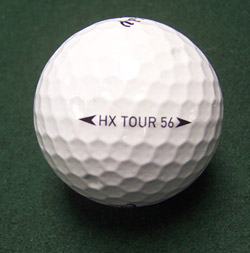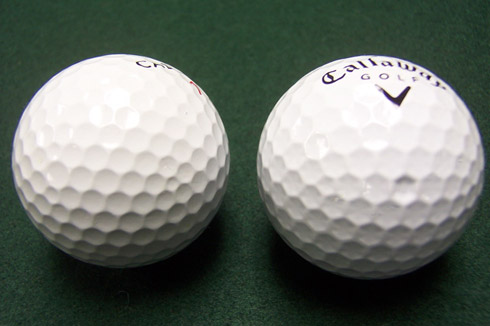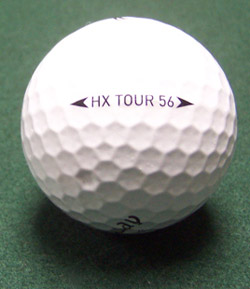 One of the worst-kept secrets in golf equipment this year is that Callaway Golf has a new ball being tested on the pro tours. While the HX Tour ball has been a staple on tour for more than a year, Phil Mickelson has been very public in his praise of this new prototype ball, code-named HX Tour 56.
One of the worst-kept secrets in golf equipment this year is that Callaway Golf has a new ball being tested on the pro tours. While the HX Tour ball has been a staple on tour for more than a year, Phil Mickelson has been very public in his praise of this new prototype ball, code-named HX Tour 56.
While the HX Tour 56 ball is generating a lot of buzz, not many details about the ball have come out. But The Sand Trap was fortunate enough to score a few sleeves of the new ball for some testing prior to the HX Tour’s scheduled mid-summer retail release. Did it live up to the HX Tour reputation?
Looks
At first glance, the HX Tour 56 looks just like its older brother. The geometric shapes of the HX pattern are in place, in contrast to traditional round dimples. The black Callaway Golf logo and chevron at the poles is joined by a sidestamp of <HX Tour 56>. The visual difference is apparent on a closer look, which reveals six of the ball’s hexagonal indentations are noticeably deeper than the other 376 craters on the ball’s surface.
Construction
Sources at Callaway told us that the deeper depressions are not designed to change the aerodynamics of the ball. Instead, they are central to the production process, helping to keep the core and mantle layer precisely centered while a thinner, softer urethane cover is injected into the mold.
This is what helps differentiate the HX Tour 56 from the original HX Tour in terms of performance. The thinner, softer cover generates more spin and softer feel on iron shots and around the greens. This was the result of requests from tour players, who wanted a ball with the HX Tour’s length off the tee combined with softer feel and more short-game spin.

The HX Tour 56 has a few deep dimples, seen here in the lower-left area of the HX Tour 56 but not in the HX Tour.
Performance
We performed a head-to-head test with the HX Tour ball and the new HX Tour 56. From tee to green, we were impressed with how the new ball held its own with one of the longest tour-worthy balls on the market.
Off the tee, distance was comparable between the two balls. The HX Tour was slightly longer off the driver, usually only by a couple yards on well-struck drives. But the HX Tour 56 was a little longer with fairway woods and hybrids, perhaps because the slightly higher spin rate worked with the more-lofted clubs to increase carry distance. Trajectory-wise, both balls were nearly identical.
Distance and ball flight with the irons was also essentially the same with both balls, but the increased spin of the HX Tour 56 was noticeable on full and partial wedge shots. Shots with the new ball checked up closer to their pitch marks on full shots, and it was easier to hit chips that checked up after a couple hops.
Feel
The HX Tour has a firm “click” on iron shots and putts, and a corresponding feel that is softer than a two-piece distance rock but harder than an old-school balata ball. In contrast, the HX Tour 56 has a much more muted sound and a more buttery feel, especially on chips an putts.

Comparison of the HX pattern (right) with a ball with traditional dimples.
First Look Conclusion
The HX Tour 56 is designed to complement the HX Tour rather than replace it, and the two provide a nice pair of options for golfers looking for a tour-level 3-piece golf ball. Which one you’ll prefer will depend on what you’re looking for in a golf ball. If you generate too much spin on your iron shots, the original HX Tour is probably right for you. That’s probably why about 60 percent of tour players using a Callaway ball have stuck with the original, including Olin Browne, who just shot a 59 using the ball in a U.S. Open qualifier.
 But if you’re looking for a little more spin around the greens without giving up distance off the tee, the HX Tour 56 will be a worthy contender for a spot in your bag. We found the added spin on wedges and short-game shots to be very valuable for scrambling and scoring. Phil Mickelson was using the ball when he shot a 59 at the PGA Grand Slam last fall, and 40 percent of Callaway ball users have switched to the new ball.
But if you’re looking for a little more spin around the greens without giving up distance off the tee, the HX Tour 56 will be a worthy contender for a spot in your bag. We found the added spin on wedges and short-game shots to be very valuable for scrambling and scoring. Phil Mickelson was using the ball when he shot a 59 at the PGA Grand Slam last fall, and 40 percent of Callaway ball users have switched to the new ball.
If you’ve played other models of Callaway golf balls, you can think of the HX Tour variants as being like the Red and Blue versions the company promotes. The HX Tour is like the Red model — a little firmer and a little longer off the driver, while the HX Tour 56 is like the Blue model — a little softer and providing more spin. The big difference isn’t off the tee, but around the greens. The HX Tour 56 is one of the softest-feeling 3-piece balls we’ve had the chance to try.
Photo Credits: © 2005 The Sand Trap .com. All rights reserved.

So, you can pay $45 or $50 or whatever the HX Tour 56 will cost in four months, or you can spend $34.99 and pick up the same ball now, but with a different name: the Tour Deep from Ben Hogan.
Right? Hmmm…
Steve: Actually, the Hogan Tour Deep and the HX Tour 56 are quite different. They do share the “deep dimple” technology to help center the core of the ball during production. But otherwise, there are few similarities. The Tour Deep is a much harder ball, harder in my opinion than the original HX Tour, and spins less on pitches and short-game shots. The HX Tour 56 is very soft in feel/sound and spins much more on iron/wedge shots. And, of course, the HX Tour 56 has the HX aerodynamics instead of the dimples of the Tour Deep, which makes the HX Tour 56 much more stable in the wind.
That’s my 2 cents. I think the two balls are very different. If the HX Tour 56 was a repackaging of the Tour Deep, then Callaway probably would have launched the two balls at the same time (and not missed out on more than six months of sales on the HX Tour 56!).
Hi guys.
Has anyone compared th HX red Vs HX tour 56?
…I’m after extra distance… Soft Feel around the greens… but most importantly more of a penetrating ball flight in windy conditions
Which ball combines all 3 points better? Is the HX tour 56 longer off the tee?
Any ideas guys?